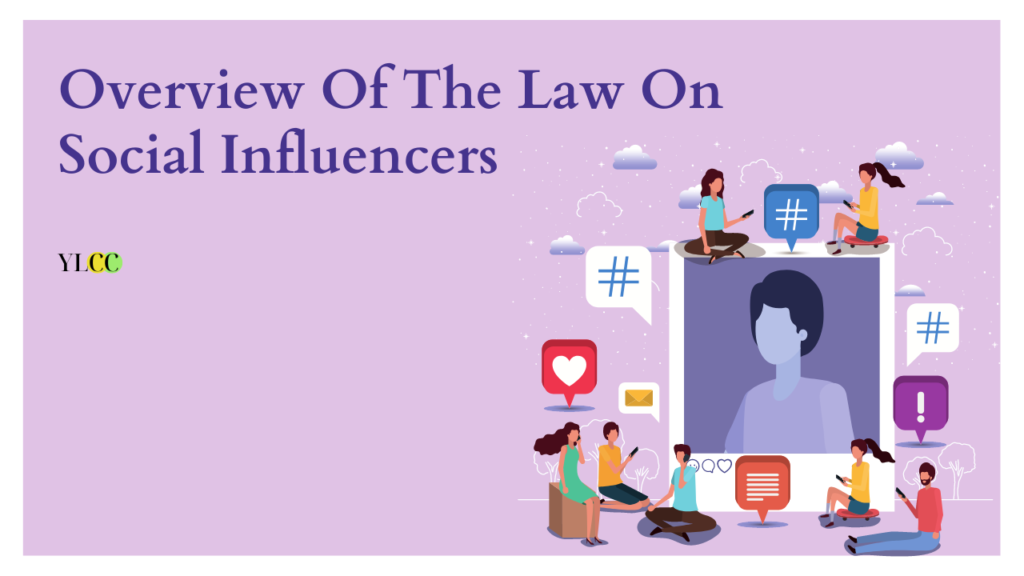
Who Is A Social Influencer?
A social media influencer is someone who has established credibility in a specific industry, has access to a huge audience and can persuade others to act based on their recommendations. In fact, influencer marketing is fast evolving to become a key tool in a company’s arsenal when done right. After all, influencers have the tools and authenticity to attract visitors consistently and can motivate others to expand their social reach. They may be anyone from a blogger to a celebrity to an online entrepreneur and capitalize on a niche to attain widespread credibility.
In this article, Team YLCC explores the legal aspects related to social influencing as imposed by Indian authorities. Read on!
Guidelines For Influencers And Influencer Marketing
In April 2019, a bench of judges at the Madras High Court passed an order calling for the ban of Tiktok for the circulation of pornography, exposure of children to disturbing content and their susceptibility to pedophiles, degrading culture, and social stigma. The Court also held that the continued use of the platform and similar other social media spaces could pose a potential threat to the issue of national security in the country. Although in the subsequent days the order was lifted due to a violation of Article 19 (1) (a) of the Indian Constitution that guarantees the right to free speech, the order created a strong impact by creating awareness of the ills of a rapidly developing social media ecosystem. Furthermore, this case brought into light certain weaknesses in Indian law and highlighted the need to reinforce privacy law. In this light, the Government of India laid down guidelines for social media apps and influencers.
Shortly thereafter, initiative was taken by the Ministry of Consumer Affairs of India. The Ministry issued a notification in the Official Gazette declaring the regulation of Social Media Influencers. After this, a draft guidelines was published which was made open to feedback from influencers, agencies, public, and stakeholders. After the conclusion of this process, the final guidelines were released by the Advertising Standards Council of India (ASCI) on March 31, 2021 and were made applicable to all social media platforms from April 15, 2021.
Given below are the highlights of the Social Media Influencer Guidelines:
- Editorial-based advertisements have to be clearly differentiated from user-created content so that the consumers (in this case, people who may or may not follow that particular profile) do not get confused or misled in any manner. The guidelines clearly state that influencers mandatorily have to add a disclosure label in the promotional posts which have to be selected from the approved list of labels available on the platform such as #ad #collab #promo #sponsored #partnership. On a formal note, the list of disclosure labels permitted that can be used individually or collectively include the following:
| Free gift | Ad |
| Sponsored | Advertisement |
| Partnership | Collaboration |
| Employee |
- Furthermore, the list of labels can be reviewed and updated from time to time by the concerned authorities. Here it is to be noted that disclosure only has to be made if the influencer is benefitting from the post (not necessarily a monetary benefit) in any way by promoting that product or service. This may include any free or discounted products or services, or any other perk such a paid vacation or any other material incentive. However, if the influencer is discussing the product without an incentive, the guidelines require no disclosure to be made.
- The disclosure label used to emphasize the advertisement should be forthright (within the first two lines of the captions so that the customer does not need to scroll or search for the same), appropriate for the profile, prominent, and suitable for all media (app or websites). Moreover, the guidelines require posting disclosures everywhere, from ABOUT ME or bios, the description of posts or videos, or any other place on the platform where a person requires to CLICK MORE to access more information.
- As far as the language of the advertisement is concerned, the mandate is to create it in English and the same should have a direct relation with the subject of the advertisement and created in a manner that the average customer can easily understand it.
- The guidelines include specific directives for video content. If a video lasts for less than or equal to 15 seconds, the disclosure label should be visible for at least 3 seconds. If a video lasts for anywhere between 15 seconds to 2 minutes, the disclosure label should visible for minimum one third- length of the video. If a video lasts longer than 2 minutes, the disclosure must appear for as long as the brand is promoted or the features benefits of the product is mentioned.
- Similar directives apply to live streams on platforms like Facebook and Instagram. In case of live streams, disclosures are to be mentioned both at the beginning and end of the stream and in case the video of the live stream is visible thereafter, then appropriate text captions need to be added. In case of only live stream, the disclosures are to be announced at the beginning, end and in between all the breaks of the streaming. Once again, the disclosures are to be clear enough to be understood by general audience.
- Due diligence has been prioritised in the new guidelines. The onus of verifying the credibility of the claims that the advertiser is making about the concerned product or service has been put on the influencer. In addition to this, the guidelines suggest that there should be a contractual agreement between the influencer and the seller which must incorporate clauses relating to disclosure, due diligence, use of filters, use of labels, etc. in order to minimise the chances of any legal dispute at a later stage.
Since its inception, the number of brand-sponsored influencer posts on Instagram has grown considerably from 1.26 million in 2016 to a whopping 6.12 million in 2020. With this unprecedented growth in the number of influencers as well as followers, a comprehensive framework for regulating social media is the need of the hour. In addition to this, the mere existence of a framework may not be a solution in itself. It is important to spread awareness about this framework and create effective channels of implementation and sanction aimed at penalising influencers who violate these regulations. These measures can go a long way to ensure that the internet remains a safe space for all.
YLCC would like to thank its Content Team for their valuable insights in this article.






